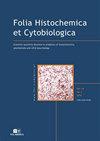GLI1参与了hif -1α-诱导的胶质瘤细胞的迁移、侵袭和上皮-间质转化。
IF 2.2
4区 生物学
Q4 BIOCHEMISTRY & MOLECULAR BIOLOGY
引用次数: 0
摘要
神经胶质瘤的特点是缺氧激活缺氧诱导因子(HIF)途径,并控制无数驱动癌症进展的基因。HIF-1α在缺氧条件下通过激活hedgehog通路促进GLI1向细胞核转移。然而,它们在缺氧条件下在胶质瘤细胞中的作用机制尚不清楚。材料与方法用HIF-1α或gli1特异性短发夹rna (shRNAs)转染人胶质瘤细胞系LN229和LN18,在常氧或缺氧条件下培养。Western blot检测大鼠HIF-1α、GLI1蛋白及上皮-间质转化(epithelial-mesenchymal transition, EMT)标志物E-cadherin、vimentin的表达水平。RT-qPCR检测HIF-1α和GLI1 mRNA的表达。细胞迁移和侵袭能力分别通过伤口愈合和Transwell试验进行评估。结果缺氧可阻断胶质瘤细胞中HIF-1α蛋白的分解,上调GLI1的表达。HIF-1α表达下调可抑制缺氧诱导的细胞迁移和侵袭,逆转缺氧对LN229和LN18细胞中GLI1、E-cadherin和vimentin表达的影响。GLI1缺失可抑制缺氧诱导的胶质瘤细胞迁移和侵袭。沉默GLI1不影响HIF-1α的表达,但完全抵消了缺氧调节的胶质瘤细胞中E-cadherin和vimentin的表达。结论sgli1参与了hif -1α-诱导胶质瘤细胞的迁移、侵袭和EMT,为胶质瘤研究揭示了新的分子机制。本文章由计算机程序翻译,如有差异,请以英文原文为准。
GLI1 is involved in HIF-1α-induced migration, invasion, and epithelial-mesenchymal transition in glioma cells.
INTRODUCTION
Glioma is characterized by hypoxia that activates the hypoxia inducible factor (HIF) pathway and controls a myriad of genes that drive cancer progression. HIF-1α promotes GLI1 transferring to the nucleus by activating the hedgehog pathway under hypoxic conditions. However, their mechanisms in glioma cells under hypoxia remain unknown.
MATERIAL AND METHODS
Human glioma cell lines (LN229 and LN18) were transfected with HIF-1α or GLI1-specific short hairpin RNAs (shRNAs) and cultured under normoxic or hypoxic conditions. The protein levels of HIF-1α, GLI1, and epithelial-mesenchymal transition (EMT) markers including E-cadherin and vimentin were measured by Western blot analysis. RT-qPCR analysis was performed for the detection of HIF-1α and GLI1 mRNA expression. Cell migratory and invasive capacities were evaluated by wound healing and Transwell assays, respectively.
RESULTS
Hypoxia blocked the breakdown of the HIF-1α protein and upregulated GLI1 expression in glioma cells. Downregulation of HIF-1α expression inhibited hypoxia-induced cell migration and invasion, as well as reversed the effects of hypoxia on GLI1, E-cadherin, and vimentin expression in LN229 and LN18 cells. Depletion of GLI1 inhibited glioma cell migration and invasion induced by hypoxia. Silenced GLI1 did not affect HIF-1α expression but completely offset hypoxia-regulated expression of E-cadherin and vimentin in glioma cells.
CONCLUSIONS
GLI1 is involved in HIF-1α-induced migration, invasion, and EMT in glioma cells, thus revealing a novel molecular mechanism for glioma research.
求助全文
通过发布文献求助,成功后即可免费获取论文全文。
去求助
来源期刊

Folia histochemica et cytobiologica
生物-生化与分子生物学
CiteScore
2.80
自引率
6.70%
发文量
56
审稿时长
6-12 weeks
期刊介绍:
"Folia Histochemica et Cytobiologica" is an international, English-language journal publishing articles in the areas of histochemistry, cytochemistry and cell & tissue biology.
"Folia Histochemica et Cytobiologica" was established in 1963 under the title: ‘Folia Histochemica et Cytochemica’ by the Polish Histochemical and Cytochemical Society as a journal devoted to the rapidly developing fields of histochemistry and cytochemistry. In 1984, the profile of the journal was broadened to accommodate papers dealing with cell and tissue biology, and the title was accordingly changed to "Folia Histochemica et Cytobiologica".
"Folia Histochemica et Cytobiologica" is published quarterly, one volume a year, by the Polish Histochemical and Cytochemical Society.
 求助内容:
求助内容: 应助结果提醒方式:
应助结果提醒方式:


